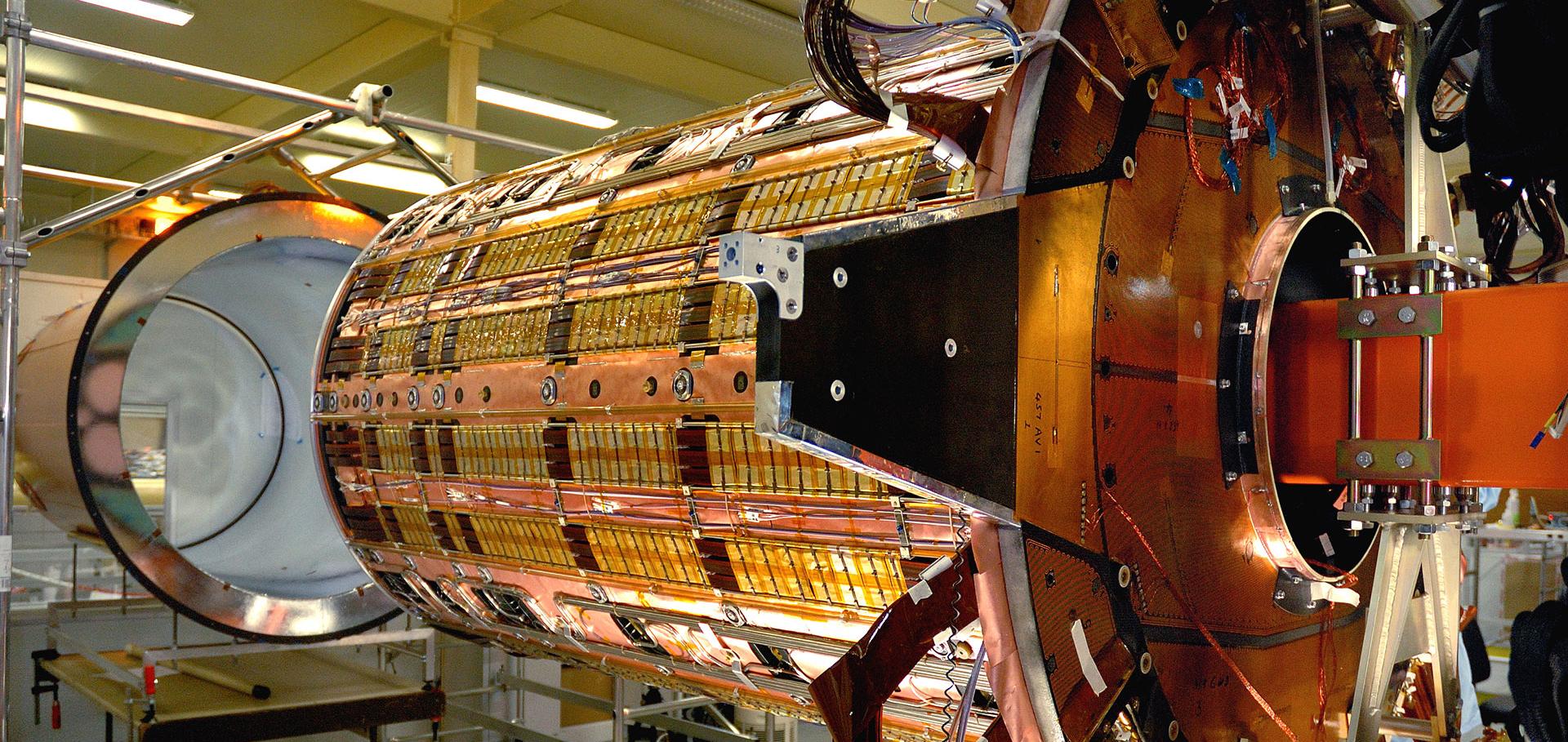B meson decays to η(′)K*, η(′)ρ, η(′)π0, ωπ0, and φπ0 -: art. no. 032006
PHYSICAL REVIEW D 70:3 (2004) ARTN 032006
Authors:
B Aubert, R Barate, D Boutigny, F Couderc, JM Gaillard, A Hicheur, Y Karyotakis, JP Lees, V Tisserand, A Zghiche, A Palano, A Pompili, JC Chen, ND Qi, G Rong, P Wang, YS Zhu, G Eigen, I Ofte, B Stugu, GS Abrams, AW Borgland, AB Breon, DN Brown, J Button-Shafer, RN Cahn, E Charles, CT Day, MS Gill, AV Gritsan, Y Groysman, RG Jacobsen, RW Kadel, J Kadyk, LT Kerth, YG Kolomensky, G Kukartsev, C LeClerc, G Lynch, AM Merchant, LM Mir, PJ Oddone, TJ Orimoto, M Pripstein, NA Roe, MT Ronan, VG Shelkov, WA Wenzel, K Ford, TJ Harrison, CM Hawkes, SE Morgan, AT Watson, M Fritsch, K Goetzen, T Held, H Koch, B Lewandowski, M Pelizaeus, M Steinke, JT Boyd, N Chevalier, WN Cottingham, MP Kelly, TE Latham, FF Wilson, T Cuhadar-Donszelmann, C Hearty, NS Knecht, TS Mattison, JA McKenna, D Thiessen, A Khan, P Kyberd, L Teodorescu, VE Blinov, AD Bukin, VP Druzhinin, VB Golubev, VN Ivanchenko, EA Kravchenko, AP Onuchin, SI Serednyakov, YI Skovpen, EP Solodov, AN Yushkov, D Best, M Bruinsma, M Chao, I Eschrich, D Kirkby, AJ Lankford, M Mandelkern, RK Mommsen, W Roethel, DP Stoker, C Buchanan, BL Hartfiel, JW Gary, BC Shen, K Wang, D del Re, HK Hadavand, EJ Hill, DB MacFarlane, HP Paar, S Rahatlou, V Sharma, JW Berryhill, C Campagnari, B Dahmes, SL Levy, O Long, A Lu, MA Mazur, JD Richman, W Verkerke, TW Beck, AM Eisner, CA Heusch, WS Lockman, T Schalk, RE Schmitz, BA Schumm, A Seiden, P Spradlin, DC Williams, MG Wilson, J Albert, E Chen, GP Dubois-Felsmann, A Dvoretskii, DG Hitlin, I Narsky, T Piatenko, FC Porter, A Ryd, A Samuel, S Yang, S Jayatilleke, G Mancinelli, BT Meadows, MD Sokoloff, T Abe, F Blanc, P Bloom, S Chen, IM Derrington, WT Ford, CL Lee, U Nauenberg, A Olivas, P Rankin, JG Smith, KA Ulmer, WC van Hoek, J Zhang, L Zhang, A Chen, JL Harton, A Soffer, WH Toki, RJ Wilson, QL Zeng, D Altenburg, T Brandt, J Brose, T Colberg, M Dickopp, E Feltresi, A Hauke, HM Lacker, E Maly, R Müller-Pfefferkorn, R Nogowski, S Otto, A Petzold, J Schubert, KR Schubert, R Schwierz, B Spaan, JE Sundermann, D Bernard, GR Bonneaud, F Brochard, P Grenier, S Schrenk, C Thiebaux, G Vasileiadis, M Verderi, DJ Bard, PJ Clark, D Lavin, F Muheim, S Playfer, Y Xie, M Andreotti, V Azzolini, D Bettoni, C Bozzi, R Calabrese, G Cibinetto, E Luppi, M Negrini, A Sarti, E Treadwell, R Baldini-Ferroli, A Calcaterra, R de Sangro, G Finocchiaro, P Patteri, M Piccolo, A Zallo, A Buzzo, R Capra, R Contri, G Crosetti, M Lo Vetere, M Macri, MR Monge, S Passaggio, C Patrignani, E Robutti, A Santroni, S Tosi, S Bailey, G Brandenburg, M Morii, E Won, RS Dubitzky, U Langenegger, W Bhimji, DA Bowerman, PD Dauncey, U Egede, JR Gaillard, GW Morton, JA Nash, GP Taylor, GJ Grenier, U Mallik, J Cochran, HB Crawley, J Lamsa, WT Meyer, S Prell, EI Rosenberg, J Yi, M Davier, G Grosdidier, A Höcker, S Laplace, F Le Diberder, V Lepeltier, AM Lutz, TC Petersen, S Plaszczynski, MH Schune, L Tantot, G Wormser, CH Cheng, DJ Lange, MC Simani, DM Wright, AJ Bevan, JP Coleman, JR Fry, E Gabathuler, R Gamet, RJ Parry, DJ Payne, RJ Sloane, C Touramanis, JJ Back, CM Cormack, PF Harrison, GB Mohanty, CL Brown, G Cowan, RL Flack, HU Flaecher, MG Green, CE Marker, TR McMahon, S Ricciardi, F Salvatore, G Vaitsas, MA Winter, D Brown, CL Davis, J Allison, NR Barlow, RJ Barlow, PA Hart, MC Hodgkinson, GD Lafferty, AJ Lyon, JC Williams, A Farbin, WD Hulsbergen, A Jawahery, D Kovalskyi, CK Lae, V Lillard, DA Roberts, G Blaylock, C Dallapiccola, KT Flood, SS Hertzbach, R Kofler, VB Koptchev, TB Moore, S Saremi, H Staengle, S Willocq, R Cowan, G Sciolla, F Taylor, RK Yamamoto, DJJ Mangeol, PM Patel, SH Robertson, A Lazzaro, F Palombo, JM Bauer, L Cremaldi, V Eschenburg, R Godang, R Kroeger, J Reidy, DA Sanders, DJ Summers, HW Zhao, S Brunet, D Coté, P Taras, H Nicholson, N Cavallo, F Fabozzi, C Gatto, L Lista, D Monorchio, P Paolucci, D Piccolo, C Sciacca, M Baak, H Bulten, G Raven, L Wilden, CP Jessop, JM LoSecco, TA Gabriel, T Allmendinger, B Brau, KK Gan, K Honscheid, D Hufnagel, H Kagan, R Kass, T Pulliam, AM Rahimi, R Ter-Antonyan, QK Wong, J Brau, R Frey, O Igonkina, CT Potter, NB Sinev, D Strom, E Torrence, F Colecchia, A Dorigo, F Galeazzi, M Margoni, M Morandin, M Posocco, M Rotondo, F Simonetto, R Stroili, G Tiozzo, C Voci, M Benayoun, H Briand, J Chauveau, P David, C de la Vaissière, L Del Buono, O Hamon, MJJ John, P Leruste, J Ocariz, M Pivk, L Roos, S T'Jampens, G Therin, PF Manfredi, V Re, PK Behera, L Gladney, QH Guo, J Panetta, F Anulli, IM Peruzzi, M Biasini, M Pioppi, C Angelini, G Batignani, S Bettarini, M Bondioli, F Bucci, G Calderini, M Carpinelli, V Del Gamba, F Forti, MA Giorgi, A Lusiani, G Marchiori, F Martinez-Vidal, M Morganti, N Neri, E Paoloni, M Rama, G Rizzo, F Sandrelli, J Walsh, M Haire, D Judd, K Paick, DE Wagoner, N Danielson, P Elmer, C Lu, V Miftakov, J Olsen, AJS Smith, AV Telnov, F Bellini, R Faccini, F Ferrarotto, F Ferroni, M Gaspero, L Li Gioi, MA Mazzoni, S Morganti, M Pierini, G Piredda, FS Tehrani, C Voena, G Cavoto, S Christ, G Wagner, R Waldi, T Adye, N De Groot, B Franek, NI Geddes, GP Gopal, EO Olaiya, R Aleksan, S Emery, A Gaidot, SF Ganzhur, PF Giraud, GH de Monchenault, W Kozanecki, M Langer, M Legendre, GW London, B Mayer, G Schott, G Vasseur, C Yèche, M Zito, MV Purohit, AW Weidemann, FX Yumiceva, D Aston, R Bartoldus, N Berger, AM Boyarski, OL Buchmueller, MR Convery, M Cristinziani, G De Nardo, D Dong, J Dorfan, D Dujmic, W Dunwoodie, EE Elsen, S Fan, RC Field, T Glanzman, SJ Gowdy, T Hadig, V Halyo, T Hryn'ova, WR Innes, MH Kelsey, P Kim, ML Kocian, DWGS Leith, J Libby, S Luitz, V Luth, HL Lynch, H Marsiske, R Messner, DR Muller, CP O'Grady, VE Ozcan, A Perazzo, M Perl, S Petrak, BN Ratcliff, A Roodman, AA Salnikov, RH Schindler, J Schwiening, G Simi, A Snyder, A Soha, J Stelzer, D Su, MK Sullivan, J Va'vra, SR Wagner, M Weaver, AJR Weinstein, WJ Wisniewski, M Wittgen, DH Wright, AK Yarritu, CC Young, PR Burchat, AJ Edwards, TI Meyer, BA Petersen, C Roat, S Ahmed, MS Alam, JA Ernst, MA Saeed, M Saleem, FR Wappler, W Bugg, M Krishnamurthy, SM Spanier, R Eckmann, H Kim, JL Ritchie, A Satpathy, RF Schwitters, JM Izen, I Kitayama, XC Lou, S Ye, F Bianchi, M Bona, F Gallo, D Gamba, C Borean, L Bosisio, C Cartaro, F Cossutti, G Della Ricca, S Dittongo, S Grancagnolo, L Lanceri, P Poropat, L Vitale, G Vuagnin, RS Panvini, S Banerjee, CM Brown, D Fortin, PD Jackson, R Kowalewski, JM Roney, HR Band, S Dasu, M Datta, AM Eichenbaum, M Graham, JJ Hollar, JR Johnson, PE Kutter, H Li, R Liu, F Di Lodovico, A Mihalyi, AK Mohapatra, Y Pan, R Prepost, AE Rubin, SJ Sekula, P Tan, JH von Wimmersperg-Toeller, J Wu, SL Wu, Z Yu, H Neal


